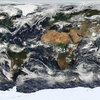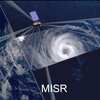

The chemical composition of the atmosphere, including gases and particles (aerosols), are continually changing as a result of natural events such as volcanic eruptions and as a result of human activities, including the effects of emissions from fossil fuel burning. Changes in composition have important consequences on air quality, the circulation processes in the atmosphere, and on climate. Observed trends include the ozone hole over Antarctica, the global trends in long-lived greenhouse gases, changes in the global concentrations of both stratospheric and tropospheric ozone, and acidic deposition in various parts of the world. Research studies suggest that dust storms emerging from deserts such as the Sahara may impact the circulations within hurricanes. Human-generated aerosols may have even larger impacts, changing the microstructure of clouds and precipitation from clouds, throughout major areas of the planet. The challenge facing atmospheric scientists is to understand these natural and human-related emissions and resulting effects on atmospheric composition, along with determining the potential effects of these changes on atmospheric processes and the resulting impacts on society. This challenge is of utmost importance in this century as human influences alter our atmosphere and climate.
Students working on atmospheric composition, chemistry, and aerosol research are looking at a variety of important questions relating to how natural events and human activities are affecting the gases and particles in the atmosphere. For example, Illinois students are studying the effects of potential climate change on air quality in North America and Asia, the effects of emissions from aviation on atmospheric chemistry and composition, and the resulting potential effects on climate, and the potential effects of newly introduced industrially-produced chemicals on air quality and stratospheric ozone. Research is also aimed at understanding the effects of dust storms in China on Asian air quality and nutrient deposition in the ocean, the interactions of this dust with urban and biomass burning air pollutants, and the resulting effects on Asia and on long-range transport of the pollutants. If you become involved in this cutting-edge research, you will have the opportunity to possibly work on some exciting field programs, the analysis of satellite and other measurement datasets, and/or use global chemistry-climate models of the Earth system such CESM and CAM-Chem, regional models such as WRF-Chem and CMAQ, or an ultra-high-resolution, fully-particle-resolved aerosol model (PartMC) in your research.
Faculty working in Atmospheric Chemistry And Aerosols



Related News
- As Larry Di Girolamo stood at Vandenberg Air Force Base in December 1999, he was a relatively new professor in what would become...
- The Department of Atmospheric Sciences has a new name: The Department of Climate, Meteorology, & Atmospheric Sciences (CliMAS). The name change was approved by the University of Illinois Board of...
- During cloud processes, aerosol particles undergo physical and chemical changes. In this work by Dr. Yu Yao, and Professor Nicole Riemer, a particle-resolved model was used to quantify the changes in...
- NASA’s Terra satellite is celebrating its 20th anniversary since launch … and it’s still going strong! Prof. Di Girolamo worked on developing Terra as a graduate student, was there at the...
- CHAMPAIGN, Ill. — The Global Carbon Project recently released its 2019 annual report, giving decision-makers access to data on atmospheric carbon concentrations, emissions and trends. Illinois...



